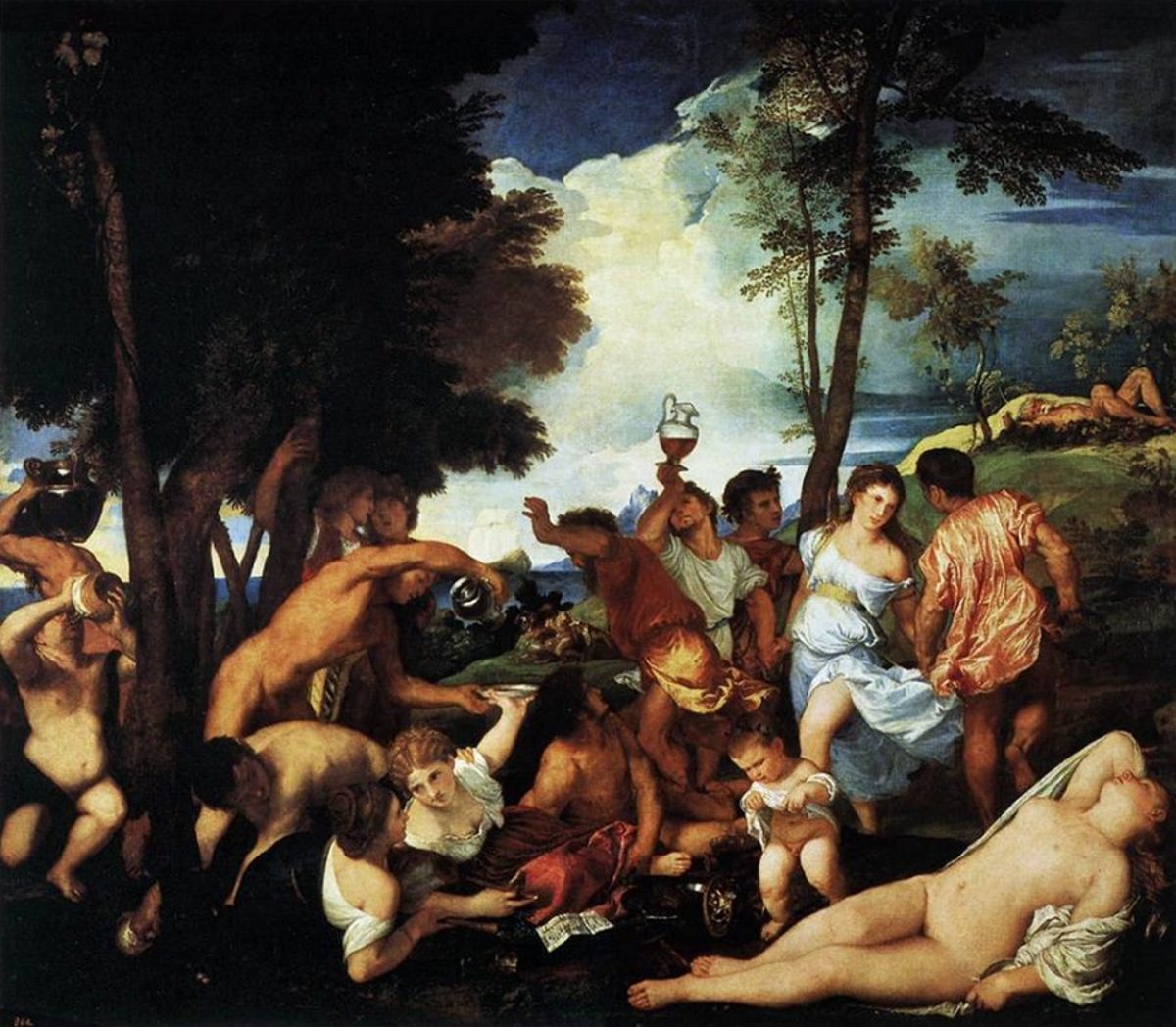New Face Of God-Fluidism Portrait Of The Supreme Being
Italian Renaissance painter, Michelangelo (1475–1564), depicted God as a classically proportioned, muscular, human male figure with long gray hair and a full graying beard. I, on the other hand, depict The Supreme Being as abstract fluid flow with indeterminate possible appearances or aspects.
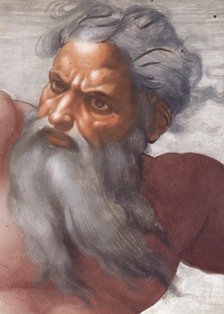
Religion, Science And Art
David Bohm (1917-1992), an unconventional theoretical physicist and controversial philosopher, has written in his highly praised book, WHOLENESS AND THE IMPLICATE ORDER (Routlege & Kegan Paul, 1980, pp 70-71):
“… since time immemorial, [humankind] has sought to understand the origin of all things and their general order and nature, in religious thought, in philosophy, and in science. … such comprehension of totality is not a reflective correspondence between ‘thought’ and ‘reality as a whole’. Rather, it is to be considered as an art form like poetry, which may dispose us toward order and harmony in the overall ‘dance of the mind’ (and thus in the general functioning of the brain and nervous system.)”
From this quote, we might interpret Bohm’s use of the phrase, “dance of the mind”, as an imaginative description of how human minds are wired to function unavoidably, indeed, as Bohm’s statement about a basic requirement of good mental health.
Modern scientific research, in fact, reveals that religious faith can boost general well-being, because an inspired, positive mind nurtures a strong, healthy body. The focus of much religious thinking, of course, is on a Supreme Being or God. And since humans are highly visual creatures, we tend to express religious faith through pictures, as well as through words. Visualization generally far outweighs verbalization, where understanding the world is a goal – remember the well-known saying, “A picture is worth a thousand words”.
Pictures Of God
The Christian faith recognizes one God as an all-powerful, all-knowing personal consciousness and caring intelligence. By comparison, the ancient Greeks recognized multiple gods. These and other world religions recognize God or gods in a variety of appearances. No matter what the faith, however, God or gods invariably take on human anatomical features.
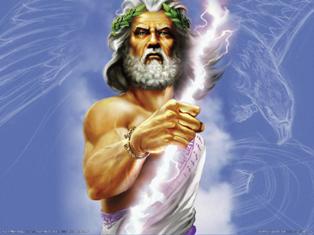
I suspect that most Westerners think of Michelangelo's famous fresco in the Sistine Chapel, when they picture God. All people seem to share a sense that the human physique is somehow enfolded into the universe.
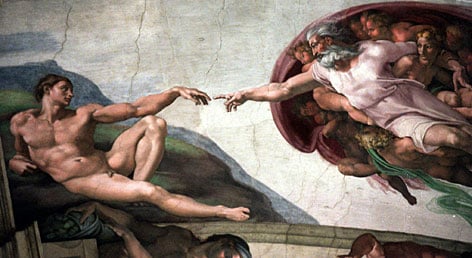
People from every culture and era use pictures of human figures to express this sense of the human physique’s enfolding into the universe. These pictures show the universe’s divine maker with human anatomical features.
We read in Genisis 1:26 (NEW WORLD TRANSLATION OF THE HOLY SCRIPTURES,1984 p 8):
“And God went on to say: ‘Let us make man in our image, according to our likeness …’”. In this poetic “dance of the mind”, God’s creating humans in His image is compatible with humans’ creating God in a human image.

Radical New Vision Of God
While the civilized world has advanced, the authority of science has surpassed the authority of religion. Traditional images of God, therefore, might seem antiquated and no longer relevant. One of today’s most groundbreaking branches of science, quantum physics, rejects the very idea of “reality” itself, thus rejecting any coherent notion of anything that a divine maker could make. Consequently, finding harmony in the idea of a Supreme Being seems challenging, even formally forbidden. What David Bohm called “the dance of the mind” has fallen apart. Humanity’s poetic thinking has lost critical support.
I believe that this state of affairs is what has caused a number of people to complain about the so-called “orthodox interpretation” or “Copenhagen Interpretation" of quantum mechanics. More precisely, the orthodox interpretation of quantum mechanics has shattered any picture of reality that ever arose from “the general functioning of the brain and nervous system” (Bohm’s phrase, remember). From a practical quantum physicist’s point of view, believing in “reality” is like believing in God.
Believing Is Seeing
The foundation of brain and nerve functions is a flesh-and-blood body whose basic anatomy and physiology remains the same as 200,000 years ago. This is the same flesh-and-blood body that produced rich metaphors of common languages, ... the same flesh-and-blood body that categorized, named objects, and told stories about perceptual experiences, ... the same flesh-and-blood body that has found harmony and health in its primal biological sensations. Humans, therefore, cannot give up the concept of “objective reality” as easily as we might give up the concept of “Supreme Being”. We need not give up either.
I propose that science and religion can condition one another to achieve a new harmony (a new order in the dance of the human mind). Furthermore, such cross-conditioning need not compromise practical procedures that enable technological advancements. Modern pictorial representations of “reality” and of “The Supreme Being”, thus, can be compatible.
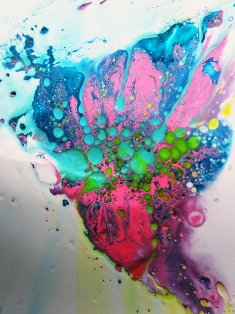
The Fluid Connection
In Aspect 396-P (pictured above), abstract fluid patterns roughly resemble an exotic human head, adorned with an elaborately jeweled headdress. This form appeared spontaneously, while manipulating liquid acrylics on the interior of a large, white salad bowl. Its original size was approximately two inches across the longest dimension. Close-up photography captured and magnified this minute appearance, before the original “painting” dispersed into a less interesting smear.
I suggest that a modern image of The Supreme Being might depend on a fluid conception of quantum mechanics. I have discussed the latter subject in three previous hubpages articles:
- Quantum Theory Alternative Fluid Dynamics Interpretation Of Objective Reality
- Quantum Theory - Artistic Sense Versus Mathematical Reasoning
- Quantum Mechanics Needs No Ontological Interpretation – Argument And Counterargument
But what does fluid dynamics have to do with The Supreme Being? My answer is that we might best picture God, NOT as a "who", but as a fluid energy-substance, ... as an entity actually existing beyond any one static representation, ... as a reality infinitely extending beyond any one absolute perpetual form.
Just as primordial turbulence in Earth’s ocean waters eventually gives birth to human organisms with faces that classical artists paint in portraiture, so can violent fluctuations in the quantum super-fluid sea give birth (through our imaginations) to a scientifically-and-religiously poetic concept of “The Supreme Being”.
This new concept of God is more liquid, ... as is the vital blood substance that flows through our veins, ... as is the cosmic plasma substance that flows through the universe.
Depths Of Being

Beyond any one face lie countless previous faces and countless future faces, born in the same grand flow of being. Everything moves together interwoven, so what we call “things” are actually wave crests. Everything, thus, has its peak of expression, where it rises up to stand out from the rest, only to sink again, in order that the next “thing” (wave crest) can achieve its peak. On the smallest scale, this action of rising and sinking happens in a rhythm so wild that we call it "random". But perhaps randomness is NOT random, rather organized in a complex way that we cannot recognize. Small-scale, wild rhythms combine to produce large-scale, less wild rhythms that we see as ordered overtones or as larger rhythms that we call “bodies” and “minds”.
Reality, thus, is an illusion, but the illusion really exists, so we must speak of it. The illusion is in perceiving higher order as disorder, where we mortals do not last long enough in the whole symphony of eternity to perceive the truth.






